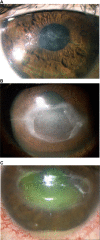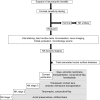Diagnosis and management of neurotrophic keratitis
- PMID: 24672223
- PMCID: PMC3964170
- DOI: 10.2147/OPTH.S45921
Diagnosis and management of neurotrophic keratitis
Abstract
Neurotrophic keratitis (NK) is a degenerative disease characterized by corneal sensitivity reduction, spontaneous epithelium breakdown, and impairment of corneal healing. Several causes of NK, including herpetic keratitis, diabetes, and ophthalmic and neurosurgical procedures, share the common mechanism of trigeminal damage. Diagnosis of NK requires accurate investigation of clinical ocular and systemic history, complete eye examination, and assessment of corneal sensitivity. All diagnostic procedures to achieve correct diagnosis and classification of NK, including additional examinations such as in vivo confocal microscopy, are reviewed. NK can be classified according to severity of corneal damage, ie, epithelial alterations (stage 1), persistent epithelial defect (stage 2), and corneal ulcer (stage 3). Management of NK should be based on clinical severity, and aimed at promoting corneal healing and preventing progression of the disease to stromal melting and perforation. Concomitant ocular diseases, such as exposure keratitis, dry eye, and limbal stem cell deficiency, negatively influence the outcome of NK and should be treated. Currently, no specific medical treatment exists, and surgical approaches, such as amniotic membrane transplantation and conjunctival flap, are effective in preserving eye integrity, without ameliorating corneal sensitivity or visual function. This review describes experimental and clinical reports showing several novel and potential therapies for NK, including growth factors and metalloprotease inhibitors, as well as three ongoing Phase II clinical trials.
Keywords: cornea innervation; cornea sensitivity; neurotrophic keratitis; persistent epithelial defect.
Figures


References
-
- Bonini S, Rama P, Olzi D, Lambiase A. Neurotrophic keratitis. Eye (Lond) 2003;17:989–995. - PubMed
-
- Groos EB., Jr . Neurotrophic keratitis. In: Krachmer JH, Mannis MJ, Holland EJ, editors. Cornea: Clinical Diagnosis and Management. St Louis, MO, USA: Mosby; 1997.
-
- Magendie F. De l’influence de la cinquieme paire de nerfs sur la nutrition et les fonctions de l’oeil. [The influence of the fifth pair of nerves on nutrition and function of the eye] J Physiol Exp Pathol. 1824;4:176–182. French.
-
- Müller LJ, Marfurt CF, Kruse F, Tervo TM. Corneal nerves: structure, contents and function. Exp Eye Res. 2003;76:521–542. - PubMed
-
- Labetoulle M, Auquier P, Conrad H, et al. Incidence of herpes simplex virus keratitis in France. Ophthalmology. 2005;112:888–895. - PubMed
Publication types
LinkOut - more resources
Full Text Sources
Other Literature Sources
Medical

